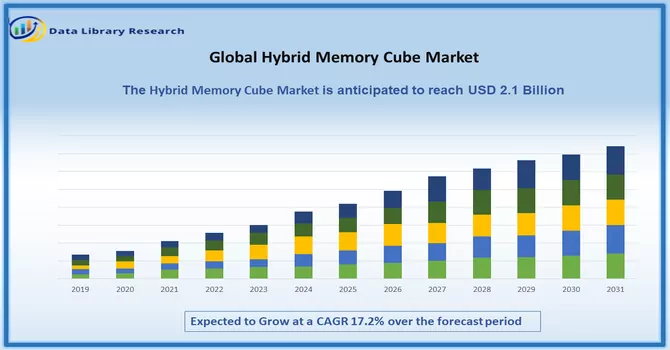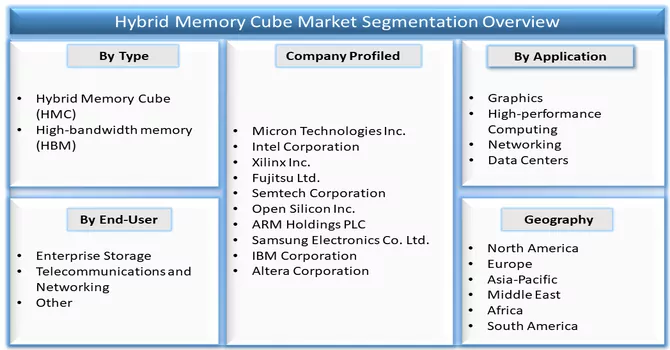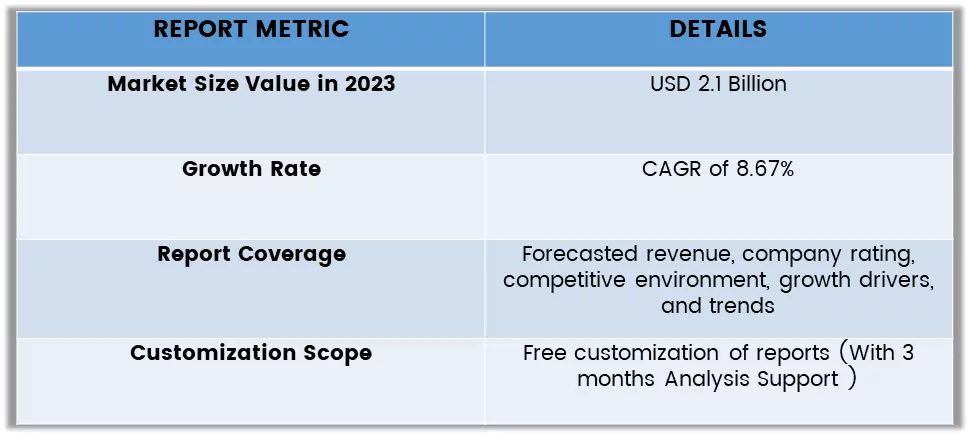The Hybrid Memory Cube Market size is estimated at USD 2.1 billion in 2023 and is expected to a CAGR of 17.2% during the forecast period (2024-2031).

Get Complete Analysis Of The Report - Download Free Sample PDF
The Hybrid Memory Cube (HMC) market is witnessing significant growth as it revolutionizes memory technology. HMC offers high-performance, energy-efficient memory solutions, representing a breakthrough in data processing capabilities. With its stacked architecture and 3D memory design, HMC provides faster data access, reduced power consumption, and improved overall system performance. The market is being driven by the escalating demand for advanced computing systems, data centers, and high-bandwidth applications that require efficient and powerful memory solutions. As technology continues to advance, HMC is poised to play a crucial role in meeting the escalating demands for faster and more efficient memory solutions across various industries.
The key driving factor for the Hybrid Memory Cube (HMC) market is its unparalleled ability to deliver high-performance and energy-efficient memory solutions. HMC's stacked architecture and 3D memory design contribute to faster data access, reduced power consumption, and enhanced overall system performance. As industries increasingly demand advanced computing capabilities and high-bandwidth applications, HMC stands out as a transformative technology, meeting the growing need for efficient and powerful memory solutions. The market is propelled by the continuous evolution of technology and the imperative for faster and more effective memory in various applications.
Market segmentation: Global Hybrid Memory Cube and High-Bandwidth Memory Market Size It is Segmented by End-User Industry (Enterprise Storage, Telecommunications and Networking, and Other End-User Industries) and Geography (North America, Europe, Asia-Pacific, Latin America, and Middle East and Africa). The Market Sizes and Forecasts are Provided in Terms of Value (USD) for all the Above Segments.

For Detailed Market Segmentation - Download Free Sample PDF
In the Hybrid Memory Cube (HMC) market, a notable trend is the increasing adoption of HMC solutions across diverse industries. As data-intensive applications and emerging technologies become more prevalent, there is a growing demand for high-bandwidth and low-latency memory solutions, which HMC effectively provides. The market is witnessing a trend towards the integration of HMC in data centers, artificial intelligence (AI) applications, and graphics processing units (GPUs), driven by the need for faster data processing and improved system performance. Additionally, advancements in HMC technology, such as increased memory density and improved power efficiency, contribute to its rising prominence in the market, reflecting a broader industry shift towards more efficient and powerful memory architectures.
Market Drivers:
High-Performance Computing (HPC) Demand
The demand for high-performance computing (HPC) solutions is rapidly increasing across various industries, driven by the need for faster data processing and analysis. Industries such as scientific research, finance, and data analytics require computing systems that can handle large amounts of data quickly and efficiently. This demand has led to the adoption of innovative technologies like Hybrid Memory Cube (HMC) in the HPC market. HMC offers several key advantages that address the requirements of HPC applications. One of the most significant benefits is its ability to deliver unprecedented memory bandwidth, allowing for faster data access and processing. This is critical for applications that require real-time data analysis or simulations, such as weather forecasting, financial modeling, and scientific research. Additionally, HMC offers reduced latency, which is essential for reducing the time it takes to access and process data. This is particularly important for applications that require high-speed data processing, such as high-frequency trading in the financial industry or real-time analytics in the data analytics industry. Thus, the adoption of HMC in the HPC market is driven by its ability to meet the demanding requirements of data-intensive computing environments. As industries continue to rely on HPC solutions for faster and more efficient data processing, the demand for HMC is expected to grow significantly in the coming years.
Rising Data Center Requirements
Data centers are facing increasing pressure to handle escalating workloads and the need for more efficient memory solutions. In this context, Hybrid Memory Cube (HMC) is emerging as a significant driver in the industry. HMC offers capabilities that enhance data transfer rates and optimize energy consumption, making it an attractive solution for data centers looking to improve their performance and efficiency. One of the key advantages of HMC is its ability to deliver higher memory bandwidth compared to traditional memory solutions. This is crucial for data-intensive applications, such as big data analytics, artificial intelligence, and machine learning, which require rapid access to large amounts of data. By providing higher memory bandwidth, HMC enables data centers to process and analyze data more quickly, leading to improved performance and efficiency. Additionally, HMC is designed to optimize energy consumption, making it a sustainable choice for data centers. The energy-efficient design of HMC helps reduce power consumption, which is essential for data centers looking to reduce their environmental impact and operating costs. The demand for improved memory architectures in data-intensive applications, cloud computing, and server environments is driving the adoption of HMC as a key memory solution. As data centers continue to grapple with increasing workloads and the need for more efficient memory solutions, HMC is poised to play a critical role in supporting the growing data processing needs of modern data centers.
Market Restraints:
The Hybrid Memory Cube (HMC) market faces several constraints that impact its widespread adoption. One significant restraint is the relatively higher cost associated with the development and implementation of HMC technology. The advanced design and integration processes, along with the use of innovative materials, contribute to elevated manufacturing expenses, limiting the affordability for certain segments of the market. Additionally, interoperability challenges and the need for specialized memory controllers can pose barriers to seamless integration into existing systems. Standardization efforts and compatibility issues must be addressed to enhance the ease of adoption and mitigate the challenges associated with HMC technology. Moreover, the complex manufacturing processes and limited ecosystem support may slow down the pace of market growth, requiring concerted efforts to overcome these barriers and unlock the full potential of Hybrid Memory Cube solutions.
The Hybrid Memory Cube (HMC) market, like many others, experienced the impact of the COVID-19 pandemic. The global disruptions caused by the pandemic led to supply chain challenges, affecting the production and distribution of electronic components, including HMC technology. Manufacturing facilities faced operational limitations, and logistical disruptions hampered the timely delivery of components, leading to delays in product launches and installations. The uncertainty in the market and economic downturn influenced investment decisions, potentially slowing down the adoption of innovative technologies such as HMC. However, the increased reliance on digital infrastructure and remote work scenarios highlighted the importance of efficient and high-performance memory solutions, potentially creating opportunities for the HMC market to rebound as the global situation stabilizes.
Segmental Analysis:
Telecommunications and Networking Segment is Expected to Witness Significant Growth Over the Forecast Period
In the telecommunications and networking industry, the demand for high-speed data processing and transmission is driving the adoption of innovative technologies like the Hybrid Memory Cube (HMC). HMC offers significant advantages for telecommunications and networking applications, including higher memory bandwidth, lower latency, and improved energy efficiency. One of the key drivers for the adoption of HMC in this industry is the need for faster and more efficient data processing. Telecommunications and networking applications require rapid data transmission and processing to support high-speed communication networks. HMC's ability to deliver higher memory bandwidth and lower latency makes it an ideal solution for these applications, enabling faster data processing and transmission speeds. Additionally, HMC's energy-efficient design is particularly beneficial for telecommunications and networking applications, where power consumption is a critical consideration. By optimizing energy consumption, HMC helps reduce operating costs and environmental impact, making it a sustainable choice for telecommunications and networking infrastructure. The growing demand for improved performance and efficiency in telecommunications and networking applications is driving the adoption of HMC in the market. As the industry continues to evolve and the demand for high-speed communication networks grows, HMC is expected to play a key role in supporting the development of faster, more efficient, and more reliable telecommunications and networking systems.
North America Region is Expected to Witness Significant Growth Over the Forecast Period
In the North America region, the Hybrid Memory Cube (HMC) market is witnessing significant growth, driven by the increasing demand for high-performance computing solutions across various industries. The superior capabilities of HMC in enhancing data transfer rates and optimizing energy consumption are key factors driving its adoption in data centers and other computing environments. The growing need for improved memory architectures in data-intensive applications, cloud computing, and server environments is further fueling the demand for HMC in the region, making it a crucial component in supporting the evolving data processing needs of modern businesses.

Get Complete Analysis Of The Report - Download Free Sample PDF
The analyzed market exhibits a high degree of fragmentation, primarily attributable to the presence of numerous players operating on both a global and regional scale. The competitive landscape is characterized by a diverse array of companies, each contributing to the overall market dynamics. This fragmentation arises from the existence of specialized solution providers, established industry players, and emerging entrants, all vying for market share. The diversity in market participants is underscored by the adoption of various strategies aimed at expanding the company presence. On a global scale, companies within the studied market are strategically positioning themselves through aggressive expansion initiatives. This often involves entering new geographical regions, targeting untapped markets, and establishing a robust global footprint. The pursuit of global expansion is driven by the recognition of diverse market opportunities and the desire to capitalize on emerging trends and demands across different regions. Simultaneously, at the regional level, companies are tailoring their approaches to align with local market dynamics. Regional players are leveraging their understanding of specific market nuances, regulatory environments, and consumer preferences to gain a competitive edge. This regional focus allows companies to cater to the unique needs of local clientele, fostering stronger market penetration. To navigate the complexities of the fragmented market, companies are implementing a range of strategies. These strategies include investments in research and development to stay at the forefront of technological advancements, mergers and acquisitions to consolidate market share, strategic partnerships for synergies, and innovation to differentiate products and services. The adoption of such multifaceted strategies reflects the competitive nature of the market, with participants continually seeking avenues for growth and sustainability. In essence, the high fragmentation in the studied market not only signifies the diversity of players but also underscores the dynamism and competitiveness that drive ongoing strategic maneuvers. As companies explore various avenues for expansion, the market continues to evolve, presenting both challenges and opportunities for industry stakeholders.
Some of the key market players are:
Recent Development:
1) In September 2023, Samsung Electronics unveiled a groundbreaking development in the DRAM market with the introduction of the Low Power Compression Attached Memory Module (LPCAMM) form factor. This advancement is poised to revolutionize personal computers, laptops, and potentially data centers. Notably, the LPCAMM exhibits an impressive speed of 7.5 gigabits-per-second (Gbps) and has undergone rigorous system verification on Intel's platform, ensuring its compatibility and reliability.
2) In May 2023, Taiwan Semiconductor Manufacturing Co. (TSMC) revealed its strategic plans to further expand investments in Japan, aiming to fortify collaborations with semiconductor partners in the region. As part of this initiative, TSMC is actively engaged in constructing its inaugural foundry in Kumamoto Prefecture, situated in Southern Japan, in partnership with Sony Group Corp. This move underscores TSMC's commitment to fostering technological advancements and strengthening its presence in key global semiconductor markets.
Q1. What was the Hybrid Memory Cube Market size in 2023?
As per Data Library Research the Hybrid Memory Cube Market size is estimated at USD 2.1 billion in 2023.
Q2. At what CAGR is the Hybrid Memory Cube market projected to grow within the forecast period?
Hybrid Memory Cube Market is expected to a CAGR of 17.2% during the forecast period.
Q3. What are the Growth Drivers of the Hybrid Memory Cube Market?
High-Performance Computing (HPC) Demand and Rising Data Center Requirements are the Growth Drivers of the Hybrid Memory Cube Market.
Q4. Which region has the largest share of the Hybrid Memory Cube market? What are the largest region's market size and growth rate?
North America has the largest share of the market. For detailed insights on the largest region's market size and growth rate request a sample here.
Data Library Research are conducted by industry experts who offer insight on industry structure, market segmentations technology assessment and competitive landscape (CL), and penetration, as well as on emerging trends. Their analysis is based on primary interviews (~ 80%) and secondary research (~ 20%) as well as years of professional expertise in their respective industries. Adding to this, by analysing historical trends and current market positions, our analysts predict where the market will be headed for the next five years. Furthermore, the varying trends of segment & categories geographically presented are also studied and the estimated based on the primary & secondary research.
In this particular report from the supply side Data Library Research has conducted primary surveys (interviews) with the key level executives (VP, CEO’s, Marketing Director, Business Development Manager and SOFT) of the companies that active & prominent as well as the midsized organization
FIGURE 1: DLR RESEARH PROCESS

Extensive primary research was conducted to gain a deeper insight of the market and industry performance. The analysis is based on both primary and secondary research as well as years of professional expertise in the respective industries.
In addition to analysing current and historical trends, our analysts predict where the market is headed over the next five years.
It varies by segment for these categories geographically presented in the list of market tables. Speaking about this particular report we have conducted primary surveys (interviews) with the key level executives (VP, CEO’s, Marketing Director, Business Development Manager and many more) of the major players active in the market.
Secondary ResearchSecondary research was mainly used to collect and identify information useful for the extensive, technical, market-oriented, and Friend’s study of the Global Extra Neutral Alcohol. It was also used to obtain key information about major players, market classification and segmentation according to the industry trends, geographical markets, and developments related to the market and technology perspectives. For this study, analysts have gathered information from various credible sources, such as annual reports, sec filings, journals, white papers, SOFT presentations, and company web sites.
Market Size EstimationBoth, top-down and bottom-up approaches were used to estimate and validate the size of the Global market and to estimate the size of various other dependent submarkets in the overall Extra Neutral Alcohol. The key players in the market were identified through secondary research and their market contributions in the respective geographies were determined through primary and secondary research.
Forecast Model
